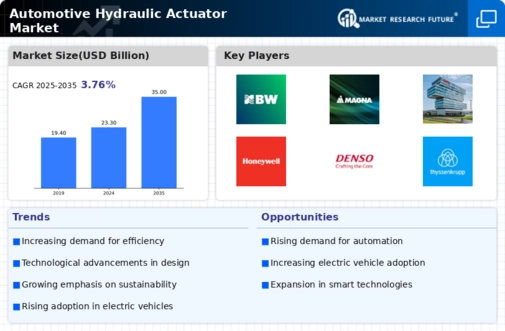The Automotive Hydraulic Actuator Market is steadily evolving, driven by a combination of technological advancements, regulatory requirements, and increasing consumer demand for efficiency and performance in vehicles. This market includes various segments such as passenger cars, commercial vehicles, and electric vehicles, each requiring specific hydraulic actuator solutions.
Competition in this sector is fierce, with many players striving to innovate and deliver superior products. Factors such as advancements in automation technology, penetration of electric vehicles, and focus on reducing fuel consumption play significant roles in shaping competitive strategies.
Companies are investing in research and development to enhance the reliability and functionality of hydraulic actuators, as well as to comply with increasingly strict automotive regulations targeting emissions and safety.
BorgWarner has established a notable presence in the Automotive Hydraulic Actuator Market, leveraging its expansive expertise in powertrain and thermal management solutions.
The company's strengths lie in its robust research and development capabilities and its commitment to sustainability, leading to the development of efficient and durable hydraulic actuators compatible with modern and emerging vehicle technologies.
BorgWarner's diversified product portfolio caters to a wide range of applications, enabling it to serve various segments effectively, including conventional fuel vehicles and hybrids.
Additionally, BorgWarner's strategic partnerships and collaborations enhance its market reach, giving it a competitive edge in innovation and customer service, which is further supported by its global manufacturing footprint, ensuring prompt delivery and local support.
Aisin Seiki's footprint in the Automotive Hydraulic Actuator Market is characterized by its rich history and a strong alignment with automotive manufacturers worldwide. Aisin Seiki is recognized for its high-quality products that focus on performance and reliability.
The company possesses significant strengths in its engineering expertise, which allows it to innovate and streamline manufacturing processes, thus facilitating the cost-effective production of hydraulic actuators.
The commitment to sustainability and environmental stewardship is also a strong point for Aisin Seiki, as it actively seeks to develop products that not only meet but exceed regulatory standards.
With a wide array of hydraulic actuators designed to cater to both passenger and commercial vehicle segments, Aisin Seiki continues to strengthen its competitive position in the market through continuous improvement and technological advancements.






















Leave a Comment